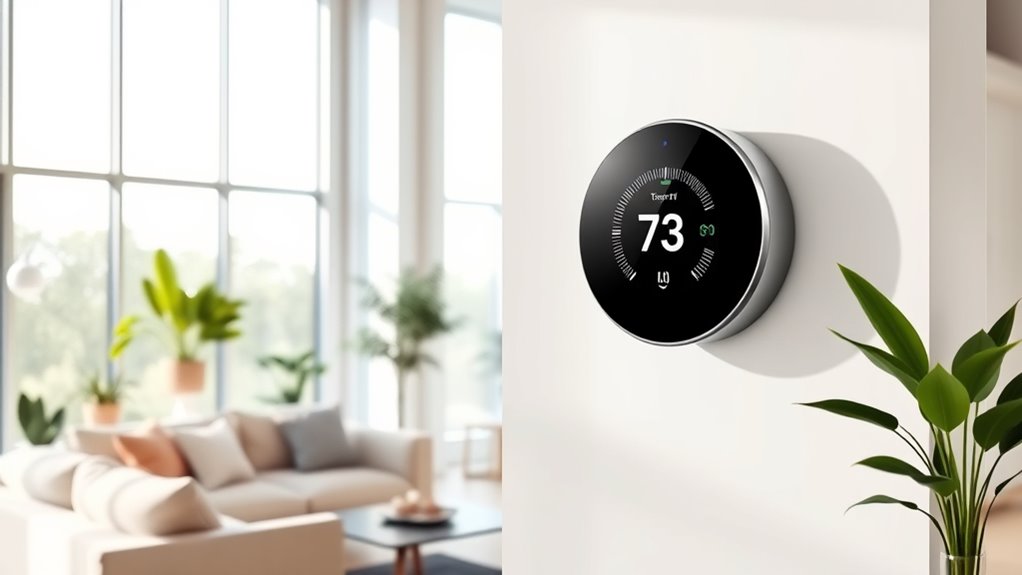If you’re looking for the top smart thermostats of 2025, I recommend models like the Nest Learning Thermostat (4th Gen) and ecobee’s latest options, which combine sleek designs with energy-saving features and smart home compatibility. These thermostats learn your routines, adjust settings automatically, and help cut your energy bills. With options supporting voice control and remote management, you’ll find a solution that fits your home. Keep exploring to discover the best fit for your comfort and savings.
Key Takeaways
- The top models like Google Nest Learning and ecobee Smart Thermostat Premium offer advanced energy-saving features and seamless smart home integration.
- Many thermostats support auto-scheduling, occupancy detection, and remote control to enhance comfort and reduce energy waste.
- Compatibility with various HVAC systems and smart home platforms ensures broad usability and easy installation.
- Features such as air quality monitoring and smart sensors contribute to healthier indoor environments and optimized climate control.
- ENERGY STAR certified options provide reliable energy savings, typically reducing heating and cooling costs significantly.
Google Nest Learning Thermostat (4th Gen, 2024)
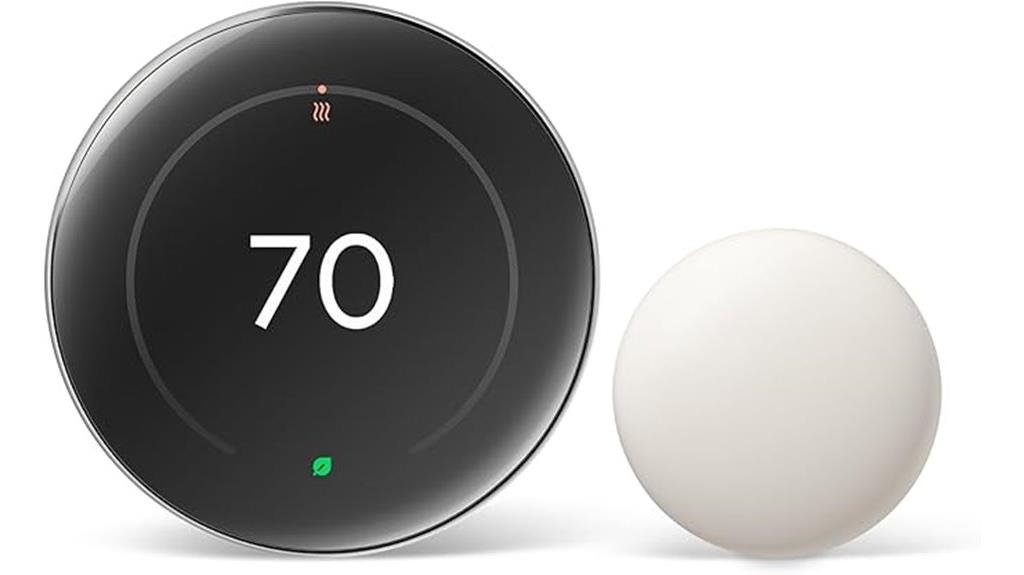
If you’re looking for a sleek, highly intelligent thermostat that adapts to your routines, the Google Nest Learning Thermostat (4th Gen, 2024) is an excellent choice. Its modern design features a polished silver finish, a larger display, and Dynamic Farsight for easy viewing from across the room. Installation is straightforward, often self-serve, with no C wire needed for most homes. It connects seamlessly to Wi-Fi and works with Alexa, Google Assistant, and Apple HomeKit. The thermostat learns your habits, auto-adjusts temperatures, and helps save energy—often reducing bills. Its intuitive interface and stylish look make it a top pick for smart home enthusiasts.
Best For: homeowners seeking a stylish, easy-to-install smart thermostat that learns routines and integrates seamlessly with popular voice assistants and smart home systems.
Pros:
- Sleek, modern design with a larger display and Dynamic Farsight for easy readability.
- Easy, mostly self-serve installation that does not require a C wire in most homes.
- Advanced smart features like auto-scheduling, learning routines, and energy-saving modes.
Cons:
- Higher price point compared to basic thermostats, which may be a consideration for some users.
- Limited compatibility outside the US, with UK users rating it around 4 stars.
- Dependence on Wi-Fi and smart integrations; less effective if connectivity issues occur.
ecobee Smart Thermostat Essential with Wi-Fi and Voice Assistant Compatibility
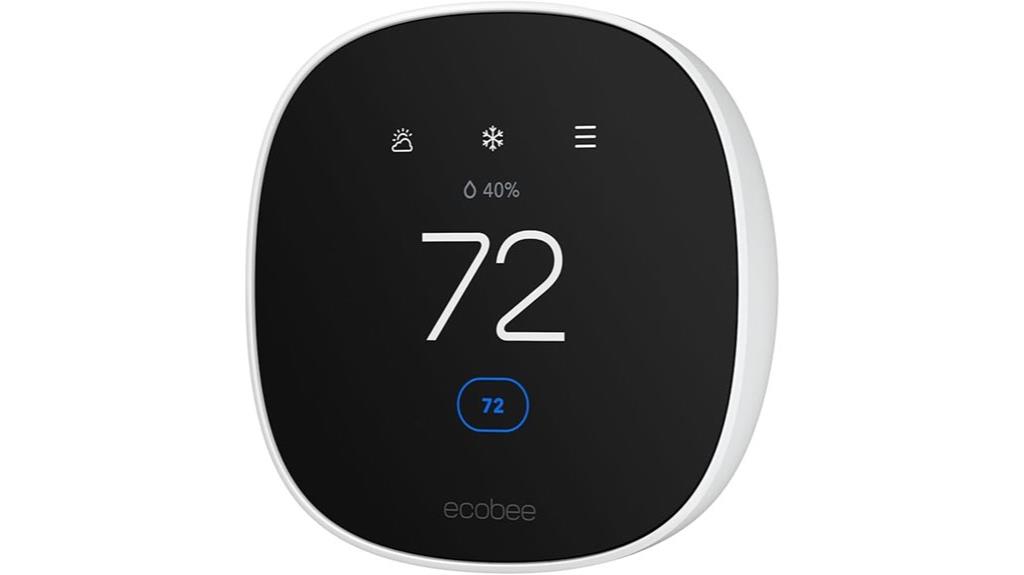
The ecobee Smart Thermostat Essential stands out for those seeking energy savings and seamless smart home integration. It can save up to 23% annually on heating and cooling costs by automatically adjusting to your schedule, conserving energy when you’re away, and boosting comfort when you’re home. The thermostat works with most HVAC systems, including gas, electric, and heat pumps, and is easy to install without a C-wire using the optional Power Extender Kit. Its intuitive touchscreen and remote control via the ecobee app make adjustments simple. Plus, it’s compatible with Apple HomeKit, Google Assistant, and Alexa, enabling voice commands and smart automation.
Best For: homeowners seeking a user-friendly, energy-efficient smart thermostat compatible with a variety of HVAC systems and smart home platforms.
Pros:
- Saves up to 23% annually on heating and cooling costs, reducing energy bills.
- Easy DIY installation with no C-wire required, thanks to the optional Power Extender Kit.
- Compatible with major smart home ecosystems like Apple HomeKit, Google Assistant, and Amazon Alexa for voice control and automation.
Cons:
- Compatibility with HVAC systems should be verified via ecobee’s online checker before purchase.
- Lacks a built-in C-wire, which may be a concern for some installations without the Power Extender Kit.
- Limited to 85% system compatibility, so certain older or specialized systems may not be supported.
ecobee Smart Thermostat Enhanced, Programmable Wi-Fi Thermostat

For homeowners seeking a smart thermostat that combines energy savings with seamless control, the ecobee Smart Thermostat Enhanced stands out. It can save up to 26% annually on heating and cooling costs by automatically adjusting temperatures when you’re away and preheating or precooling before you arrive. Its user-friendly setup includes a Power Extender Kit, so no C-wire is needed, and it’s compatible with most HVAC systems. You can control it remotely via smartphone, tablet, or Apple Watch. Plus, it integrates with Siri, Alexa, and Google Assistant, offering voice control and room-specific temperature monitoring for personalized comfort.
Best For: homeowners seeking an energy-efficient, easy-to-install smart thermostat with seamless remote control and smart home compatibility.
Pros:
- Saves up to 26% annually on heating and cooling costs through automatic adjustments and preconditioning.
- User-friendly installation with Power Extender Kit, eliminating the need for a C-wire and battery replacements.
- Compatible with most HVAC systems and integrates with Siri, Alexa, and Google Assistant for voice control.
Cons:
- May not be compatible with certain older or non-standard HVAC systems.
- Advanced features and setup might require a learning curve for some users.
- Requires Wi-Fi connection for remote control and smart features, which could impact functionality during outages.
ecobee Smart Thermostat Premium with Sensors

The ecobee Smart Thermostat Premium with Sensors stands out as an ideal choice for homeowners seeking both energy savings and advanced home monitoring. It can cut heating and cooling costs by up to 26% annually and is ENERGY STAR certified. Its SmartSensors eliminate hot and cold spots by adjusting temperatures in key rooms, boosting comfort and efficiency. The thermostat detects open windows or doors, pausing HVAC to save energy. It also features occupancy sensing, geofencing, and built-in air quality monitoring, alerting you to poor air conditions. With compatibility across most 24VAC HVAC systems and seamless smart home integration, it’s a powerful, user-friendly device for smarter, more efficient living.
Best For: homeowners seeking to reduce energy costs, improve home comfort with smart temperature zoning, and enhance home safety with integrated monitoring features.
Pros:
- Up to 26% annual energy savings and ENERGY STAR certified for efficiency.
- Advanced sensors and occupancy features optimize comfort and reduce hot/cold spots.
- Seamless compatibility with most 24VAC HVAC systems and smart home platforms like Alexa, Google, and Apple.
Cons:
- Regional restrictions may limit some location-based features and sensor functionality.
- Requires Apple Home Hub for Siri integration, which adds an extra device requirement.
- Some users report that setup can be tricky if HVAC power is not properly disconnected beforehand.
ecobee Smart Thermostat Essential with Wi-Fi and Voice Assistant Compatibility
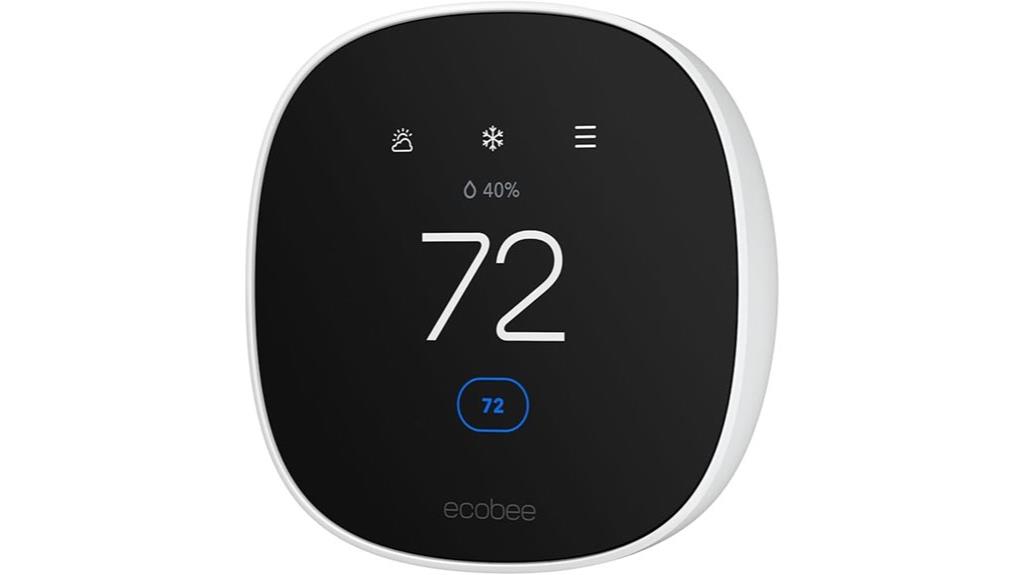
If you’re looking to optimize your home’s energy use without complicated installations, the ecobee Smart Thermostat Essential is an excellent choice. It can save you up to 23% annually on heating and cooling costs by automatically adjusting to your schedule, conserving energy when you’re away, and boosting comfort when you’re home. You can track your energy consumption remotely via the ecobee app, and software updates keep it running smoothly. Compatible with most HVAC systems, it’s easy to install with no C-wire needed if you use the Power Extender Kit. It also integrates seamlessly with voice assistants like Alexa, Google, and Apple HomeKit.
Best For: homeowners seeking an energy-efficient, easy-to-install smart thermostat compatible with multiple voice assistants and HVAC systems.
Pros:
- Saves up to 23% annually on heating and cooling costs.
- Easy DIY installation with no C-wire needed, thanks to the Power Extender Kit.
- Compatible with leading smart home platforms like Apple HomeKit, Google Assistant, and Amazon Alexa.
Cons:
- Compatibility with HVAC systems should be verified via the online checker before purchase.
- May require additional accessories like the trim kit for wall aesthetics.
- Limited to 85% of HVAC systems, so some older or specialized systems might not be compatible.
Amazon Smart Thermostat

Those seeking an easy-to-install smart thermostat that seamlessly integrates with Alexa and Ring devices will find the Amazon Smart Thermostat to be an excellent choice. It’s compatible with most HVAC systems, requires a C-wire for setup, and combines Honeywell’s trusted technology for reliability. With ENERGY STAR certification, it helps save around $50 annually on energy bills by automatically adjusting temperature based on presence or readings. You can control it remotely via the Alexa app or simply ask Alexa to change the temperature. Amazon also offers helpful customer support and information on rebates, making this thermostat a smart, energy-efficient upgrade for any home.
Best For: homeowners seeking an easy-to-install, energy-efficient smart thermostat that integrates seamlessly with Alexa and Ring devices.
Pros:
- Compatible with most HVAC systems and requires only a C-wire for installation
- Helps save approximately $50 annually on energy bills with ENERGY STAR certification
- Remote control and voice command features via Alexa app and Alexa voice assistant
Cons:
- Requires a C-wire for installation, which may not be present in all homes
- Limited to homes with compatible HVAC systems and Alexa/Ring devices
- Setup and troubleshooting may still require some technical familiarity despite app guidance
Sensi Smart Thermostat with Wi-Fi and Alexa Compatibility
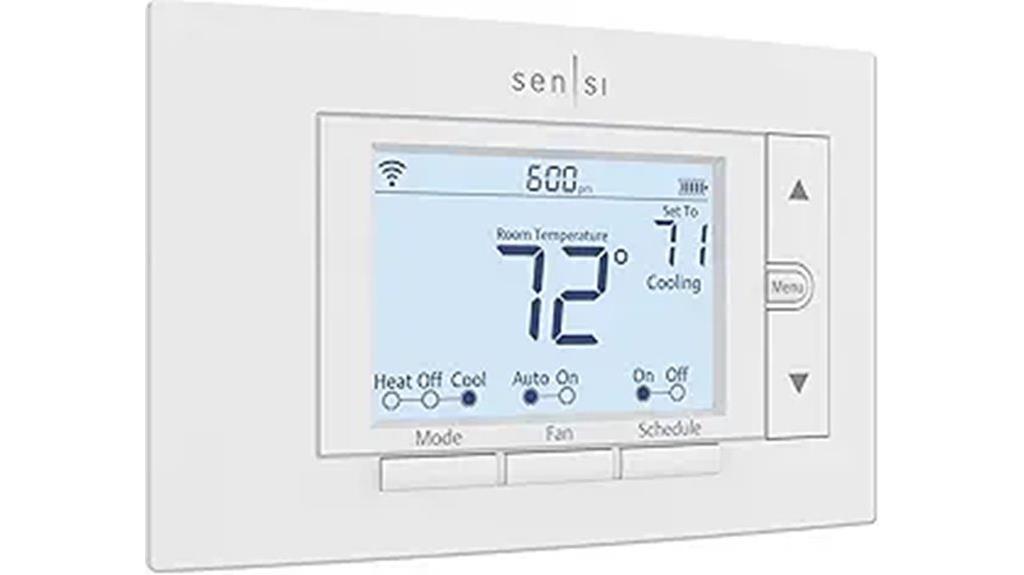
For homeowners seeking an easy-to-install smart thermostat that doesn’t require a C-wire, the Sensi Smart Thermostat with Wi-Fi and Alexa compatibility stands out as an excellent choice. It works with most HVAC systems and features a sleek design with a 5-inch LED display. Setup is straightforward with step-by-step app instructions, and its built-in level simplifies mounting. The thermostat offers programmable controls, voice commands through Alexa and other assistants, and remote access via the app. Certified Energy Star, it can cut HVAC energy use by about 23%. Many users appreciate its reliability, easy installation, and privacy focus, making it a top pick for energy savings and convenience.
Best For: homeowners seeking an easy-to-install, privacy-conscious smart thermostat compatible with most HVAC systems and without the need for a C-wire.
Pros:
- No C-wire required, simplifying installation, especially in complex or older systems
- Easy DIY setup with step-by-step app guidance and built-in level
- Energy Star certified, helping reduce HVAC energy consumption by approximately 23%
Cons:
- Limited detailed usage data and no breakdown of run times in the app
- Some delays in HVAC response time after changing settings (around 20-25 seconds)
- Lacks support for Bixby and more advanced integrations beyond Alexa, Google Assistant, SmartThings, and Vera
ecobee Smart Thermostat Enhanced, Programmable Wi-Fi Thermostat

The ecobee Smart Thermostat Enhanced stands out for its energy-saving capabilities, making it an excellent choice for homeowners looking to cut heating and cooling costs without sacrificing comfort. It can save up to 26% annually by automatically adjusting temperatures when you’re away and preconditioning your home before you arrive. The thermostat also maintains ideal humidity levels for consistent comfort day and night. Easy to install with a Power Extender Kit, it works with most HVAC systems and integrates seamlessly with smart home devices like Alexa, Siri, and Google Assistant. Plus, remote control via smartphone or Apple Watch makes managing your climate effortless.
Best For: homeowners seeking an energy-efficient, easy-to-install smart thermostat that offers remote control and seamless integration with popular smart home platforms.
Pros:
- Saves up to 26% annually on heating and cooling costs through automatic adjustments and preconditioning.
- Compatible with most 24 VAC HVAC systems, including gas, electric, oil, dual fuel, and heat pump systems.
- Easy installation with Power Extender Kit and control via smartphone, tablet, or Apple Watch.
Cons:
- May not be compatible with systems requiring a 24 V common wire (C-wire) without the Power Extender Kit.
- Requires a stable Wi-Fi connection for optimal remote features and integration.
- Some users might find setup and configuration complex if unfamiliar with smart home devices.
ecobee Smart Thermostat Premium with Sensor and Air Quality Monitor

If you’re looking to maximize comfort and energy savings, the ecobee Smart Thermostat Premium with Sensor and Air Quality Monitor is an excellent choice. It can cut heating and cooling costs by up to 26% annually and is ENERGY STAR certified. The SmartSensors eliminate hot and cold spots by adjusting temperature in key rooms, improving efficiency. It detects open windows or doors, pausing HVAC to save energy. Plus, its advanced occupancy sensing and geofencing optimize use based on home presence. Built-in air quality monitoring alerts you to poor air conditions, and security features like smoke detection and break-in notifications add safety, making it a versatile upgrade.
Best For: homeowners seeking to maximize energy efficiency, home comfort, and integrated safety features with a smart, versatile thermostat.
Pros:
- Reduces heating and cooling costs by up to 26% annually with ENERGY STAR certification
- Advanced sensors and geofencing optimize comfort based on home occupancy and eliminate hot/cold spots
- Built-in air quality and safety monitoring, including smoke detection and security alerts
Cons:
- Regional restrictions on location services and sensor functionality may limit some features
- Requires Apple Home Hub for Siri integration, adding an extra component for Apple users
- Setup can be more complex in homes without a compatible 24VAC HVAC system or C-wire, despite the included Power Extender Kit
Google Nest Thermostat, Programmable Wi-Fi Thermostat
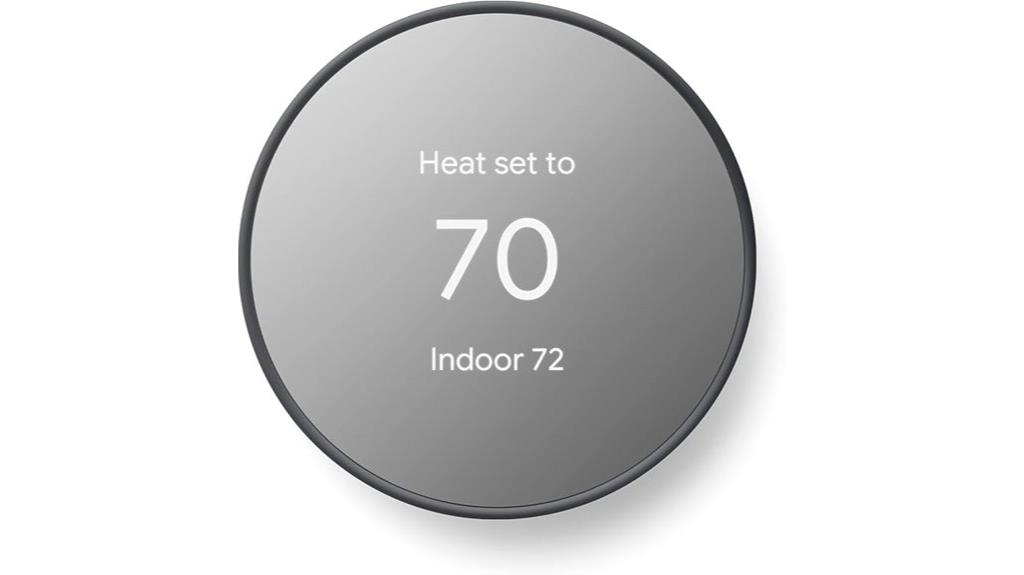
With its sleek design and user-friendly app control, the Google Nest Thermostat is ideal for homeowners seeking an easy-to-install, energy-saving solution. It’s ENERGY STAR certified, helping you cut energy costs while maintaining comfort. The device supports remote adjustments through the Google Home app on Android and iPhone, and it works with voice commands via Alexa and Google Assistant. Installation is straightforward, typically taking less than 30 minutes, and it’s compatible with various HVAC systems, including heat pumps. Its automatic learning capabilities optimize your schedule, and HVAC alerts keep you informed about potential issues. Overall, it’s a reliable, modern choice for smarter home climate control.
Best For: homeowners seeking an easy-to-install, energy-efficient smart thermostat with remote control and compatibility with various HVAC systems.
Pros:
- User-friendly app control and sleek modern design
- ENERGY STAR certified for energy savings and cost reduction
- Supports voice commands via Alexa and Google Assistant
Cons:
- Requires stable Wi-Fi connection for optimal remote functionality
- May need a C wire or power accessory for certain HVAC setups
- Initial setup can be challenging if wiring is complex or unfamiliar
Non-Programmable Digital Thermostat for Home

A non-programmable digital thermostat is an excellent choice for homeowners who want simple, reliable temperature control without the complexity of advanced features. It’s easy to install yourself, with clear instructions and a straightforward design. The large LCD backlight display and push button controls make adjusting settings quick and hassle-free. It supports single-stage systems, like gas or electric furnaces, and doesn’t require a common wire. With features like separate swing adjustments for heating and cooling and a low battery indicator, it helps optimize comfort and energy savings. Overall, it’s a dependable, budget-friendly option for those seeking basic yet effective temperature management.
Best For: homeowners seeking an easy-to-install, reliable, and budget-friendly non-programmable thermostat for single-stage heating and cooling systems.
Pros:
- Simple DIY installation with clear instructions and minimal wiring needs
- Large LCD backlight display and push button controls for easy operation
- Supports energy-saving features like separate swing adjustments and low battery indicator
Cons:
- Not compatible with multistage heat/cooling systems or heat pumps with auxiliary heating
- Limited to single-stage systems, restricting use in more complex HVAC setups
- No programmable scheduling features for automated temperature adjustments
Lux TQ1 Smart Digital Thermostat for Home

The Lux TQ1 Smart Digital Thermostat stands out for homeowners seeking a sleek, modern device that’s easy to install and integrates seamlessly with popular smart home platforms. Its minimalist black finish and touchscreen make it both stylish and user-friendly. Compatible with various systems, including heat pumps, PTAC units, and fan coils, it supports the Matter protocol for broad smart home integration with Apple, Google, Alexa, and SmartThings. Setup is quick via the app, and wiring options include a C-wire or Power Bridge. While easy to use, some users report temperature accuracy issues and occasional connectivity challenges, so it’s best for those prioritizing design and smart home compatibility over pinpoint climate control.
Best For: homeowners seeking a sleek, easy-to-install smart thermostat that integrates effortlessly with major smart home platforms and values modern design over ultra-precise temperature control.
Pros:
- Stylish, minimalist black finish with a user-friendly touchscreen display
- Supports the Matter protocol for broad compatibility with Apple Home, Google Home, Alexa, and SmartThings
- DIY-friendly installation with flexible wiring options and clear instructions
Cons:
- Potential temperature accuracy issues when the screen is active, up to 5°F higher than actual
- Some users experience connectivity or compatibility challenges, requiring troubleshooting or reinstallation
- Higher price point (~$100) compared to competitors offering similar features at lower costs
Sensi Touch 2 Smart Thermostat with Touchscreen
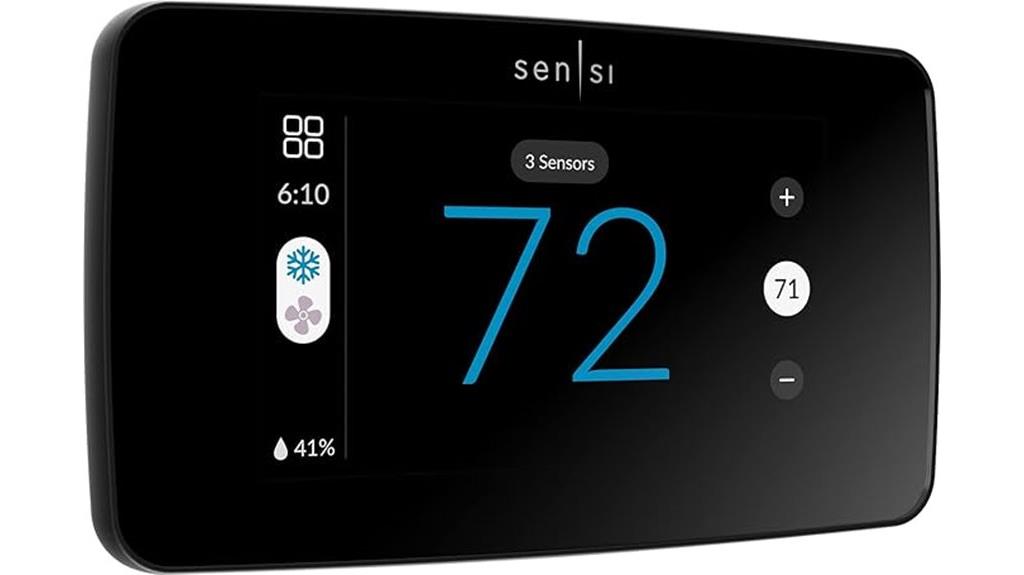
If you’re looking for a smart thermostat that combines a sleek touchscreen interface with reliable performance, the Sensi Touch 2 is an excellent choice. It features a colorful, easy-to-read display, Wi-Fi connectivity, and is Energy Star certified, helping you save around 23% on HVAC costs. Its simple DIY installation, guided by the app, makes setup quick, especially if you have a common C-wire. Compatible with smart home systems like Alexa and Google Assistant, it offers flexible scheduling, remote control, and smart maintenance alerts. Its intuitive interface and compatibility with optional sensors enhance comfort, efficiency, and peace of mind—all wrapped in a stylish design.
Best For: homeowners seeking an easy-to-install, energy-efficient smart thermostat with a sleek touchscreen interface and smart home integration capabilities.
Pros:
- User-friendly touchscreen display with clear, colorful interface
- Easy DIY installation guided by the app, with detailed instructions
- Compatible with popular smart home systems like Alexa, Google Assistant, and Samsung SmartThings
Cons:
- Wi-Fi setup can sometimes be challenging, with PIN changes causing confusion after failed attempts
- Requires a common (C-wire) for power, which may not be available in all homes
- Some users report initial connectivity issues during setup, though performance stabilizes afterward
Cielo Smart Thermostat Eco, Energy Star Certified
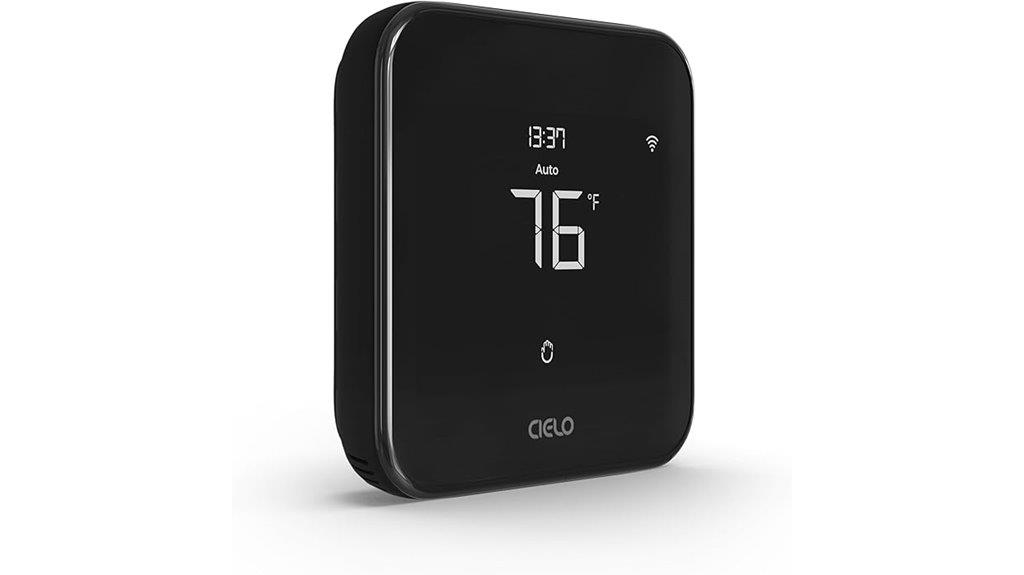
For homeowners seeking an eco-friendly, energy-efficient thermostat, the Cielo Smart Thermostat Eco stands out with its ENERGY STAR certification and broad HVAC compatibility. It helps reduce heating and cooling bills while working with most 24V systems, including gas, electric, oil, heat pumps, and geothermal setups. Installation is straightforward, with a free C-Wire adapter for homes without one. You can control it remotely via iOS or Android apps, set personalized schedules, and monitor energy use with detailed insights. Its Vacation Mode protects your home from extreme temperatures during absences, making it a smart choice for energy savings and comfort.
Best For: homeowners seeking an energy-efficient, easy-to-install smart thermostat compatible with a wide range of HVAC systems and looking for remote control and energy insights.
Pros:
- ENERGY STAR certified for proven energy savings and efficiency
- Compatible with most 24V HVAC systems, including heat pumps and geothermal setups
- Easy DIY installation with a free C-Wire adapter included
Cons:
- Not compatible with mini split systems
- Limited to conventional and heat pump HVAC configurations (up to 4H/2C for heat pumps)
- Requires smartphone app for full remote control and scheduling functionality
Sensi Lite Smart Thermostat

Designed for homeowners seeking an easy-to-install and energy-efficient smart thermostat, the Sensi Lite stands out with its straightforward DIY setup and compatibility with most HVAC systems. It features built-in level and step-by-step instructions, making installation simple. Compatible with Alexa and Wi-Fi, it allows remote control via a highly-rated mobile app for Android and iOS. Certified by ENERGY STAR, it helps users save around 23% on energy costs through flexible scheduling, geofencing, and usage reports. Most systems don’t need a C-wire, except for heat/cool or heat pump systems, ensuring broad compatibility and hassle-free installation.
Best For: homeowners seeking an easy-to-install, energy-efficient smart thermostat compatible with most HVAC systems and remote control capabilities.
Pros:
- Easy DIY installation with built-in level and step-by-step instructions
- Compatible with Alexa, Wi-Fi, and mobile apps for remote management
- ENERGY STAR certified, helping save approximately 23% on energy costs
Cons:
- May require a C-wire for heat/cool or heat pump systems
- Limited advanced programming features compared to more premium thermostats
- Does not include a display screen on the thermostat itself
Factors to Consider When Choosing Smart Thermostats

When choosing a smart thermostat, I consider how well it works with my HVAC system and how easy it is to use. I also look at whether it can connect with my other smart home devices and offers features that save energy. Finally, I check if the installation process is straightforward and fits my home’s setup.
Compatibility With HVAC Systems
Making sure your smart thermostat is compatible with your HVAC system is vital to get the most out of your upgrade. First, check that it matches your system’s voltage, stages, and type—whether it’s single-stage, multi-stage, or a heat pump. You’ll also want to see if your system needs a C-wire for power or if the thermostat supports wireless installation options. Additionally, verify whether it supports special features like auxiliary heat, dual fuel setups, or multi-zone control. Compatibility with your system’s control protocols, such as proprietary signals or standard 24V connections, is essential. Before purchasing, review manufacturer lists or online checkers to confirm support. Making sure these factors align helps guarantee seamless operation and maximizes the energy savings and comfort benefits of your smart thermostat.
User Interface Ease
Choosing a smart thermostat with an easy-to-use interface can make managing your home’s climate much simpler. An intuitive interface with clear visuals and straightforward controls reduces setup time and frustration. Touchscreens with customizable displays and simple navigation menus let you quickly access key functions like temperature adjustments and scheduling. Physical buttons or dials should be logically arranged and responsive, offering reliable manual control without hassle. A readable display with adjustable brightness and large fonts improves visibility, especially for those with visual impairments. Additionally, a consistent and responsive app interface that mirrors the thermostat’s functions makes remote management seamless. Prioritizing user interface ease guarantees you spend less time figuring out controls and more time enjoying a comfortable home.
Smart Home Integration
Smart home integration is a crucial factor to contemplate because it determines how well your thermostat communicates with other devices and platforms. Compatibility with popular systems like Alexa, Google Assistant, Apple HomeKit, and SmartThings ensures seamless voice control and automation. Support for protocols like Matter enhances interoperability, future-proofing your setup as new devices emerge. Integrating smart sensors allows room-specific temperature control, boosting comfort and efficiency across different zones. Remote management via smartphone apps lets you adjust settings and monitor energy use from anywhere, adding convenience. However, compatibility with existing ecosystems may require checking system requirements or adding hubs and adapters for peak performance. Overall, strong integration options make your smart thermostat more versatile and easier to control within your smart home.
Energy Saving Features
Energy-saving features play a significant role in maximizing the benefits of a smart thermostat. These features can cut your heating and cooling costs by up to 26% annually by optimizing energy use. Auto-scheduling, learning routines, and auto-adjustments help reduce HVAC operation when no one’s home. Many models include occupancy sensors and geofencing, which automatically adjust temperatures based on whether you’re home or away, boosting efficiency. Integration with energy-saving programs and rebates can further lower costs and benefit the environment. Monitoring tools and usage reports provide insights into your energy consumption, helping you identify opportunities to save even more. Prioritizing these features ensures your smart thermostat not only enhances comfort but also delivers significant energy and cost savings over time.
Installation Requirements
When selecting a smart thermostat, understanding installation requirements is essential to guarantee compatibility and a smooth setup process. Most models need a C-wire for continuous power, but many offer alternatives like power extenders or batteries. Compatibility with your existing HVAC system is key; some thermostats only support single-stage systems, while others handle multi-stage or heat pump setups. Installation complexity varies—some units are straightforward DIY projects with clear instructions, while others may require professional help. The presence or absence of a C-wire influences installation time and may necessitate additional wiring adapters or power extenders. Before buying, verify your system’s compatibility and whether your setup supports the chosen thermostat to avoid surprises during installation.
Frequently Asked Questions
How Do Smart Thermostats Impact Long-Term Energy Savings?
Smart thermostats help me save energy in the long run by learning my schedule and adjusting temperatures automatically. I no longer waste energy when I’m away or asleep because they optimize heating and cooling efficiently. Plus, I can control them remotely, ensuring I only use energy when needed. Over time, I see lower utility bills and a smaller carbon footprint, making my home more sustainable and cost-effective.
Are Smart Thermostats Compatible With All HVAC Systems?
Smart thermostats are like universal remote controls—most are compatible with a wide range of HVAC systems, but not all. I recommend checking your system’s compatibility before buying, as some older or specialized setups might need additional wiring or adapters. Many brands provide compatibility guides online, making it easier to find the perfect match. If you’re unsure, consulting an HVAC professional can save you headaches later.
What Security Measures Protect Smart Thermostat Data?
Smart thermostats use encryption, secure Wi-Fi protocols, and regular software updates to protect your data. I make sure to change default passwords and enable two-factor authentication whenever possible. Manufacturers also implement firewalls and monitor for suspicious activity to keep your information safe. Rest assured, these security measures are designed to prevent unauthorized access, so your data stays private while you enjoy smarter, more efficient climate control.
Can Smart Thermostats Be Integrated With Other Smart Home Devices?
Yes, smart thermostats can be integrated with other smart home devices. I’ve connected mine with my smart lights, security cameras, and voice assistants to create a seamless, automated experience. This integration allows me to control everything from one app or voice command, making my home more efficient and comfortable. Most modern thermostats support popular platforms like Alexa, Google Home, and Apple HomeKit, making setup straightforward and flexible.
How Easy Is Installation for Non-Technical Users?
Installing smart thermostats is simple and straightforward for non-technical users. Most models come with clear, concise instructions and user-friendly interfaces that make setup seamless. I found the process smooth, with step-by-step guides that walk you through wiring and connecting to your Wi-Fi. Plus, many thermostats offer app-based setup, allowing you to control and customize your climate comfort quickly, without any complicated tools or technical know-how.
Conclusion
Choosing the right smart thermostat can save you up to 12% on energy bills, according to recent studies. With so many great options like the Google Nest Learning Thermostat and ecobee’s advanced models, you’re set to boost comfort while cutting costs. Remember, a well-chosen thermostat not only saves money but also reduces your carbon footprint. So, take your time, consider your needs, and enjoy a smarter, more efficient home today!
